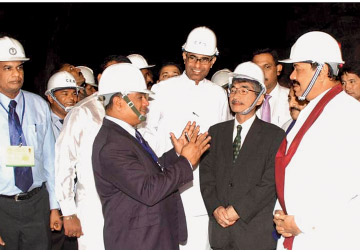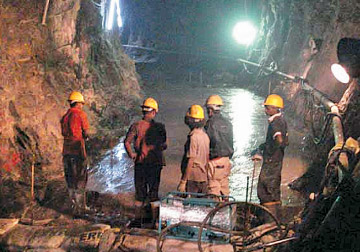|
Whopping income of Rs. 5.8 b:
Upper Kotmale to help reduce power tariffs
By Shirajiv Sirimane

President Mahinda Rajapaksa listens to Japanese technical
experts |

The President with Power and Energy Minister Champika Ranawaka |
One of the most debt-ridden state institutions to the government,
Ceylon Electricity Board (CEB) would see light at the end of the tunnel
which could thus turn around the scenario with the commissioning of the
Upper Kotmale hydro power project.

The tunnel entrance |

The interior of the tunnel |
The CEB would be able to earn an unprecedented income of Rs. 5.8
billion annually with the commissioning of the project which was on
paper from 1985.
The CEB had no option other than to purchase electricity generated by
diesel since not a single power plant was built annually for the past
several years which forced the CEB to ‘waste’ Rs. 6.23 billion annually.
However, the trend would see a reverse when the CEB will become a
profit making venture with the Upper Kotmale adding 409 million giga
watts per year. Minister of Power and Energy Champika Ranawaka said that
the main reason for the Electricity Board for being in the ‘red’ is
because of the gigantic amount they have shell out to pay for thermal
energy generation.
The CEB purchases a thermal powered electrical unit for around Rs.
17. 58 and sells it to the consumer for less than Rs. 13. During peak
hours CEB is forced to generate thermal energy for around Rs. 45.
With the Upper Kotmale CEB would be able to generate electricity for
less than Rs. 2 and be able to save billions.
The CEB’s plight was due to irresponsible decisions of politicians
who were never interested in this project for reasons best known only to
them.
Had the project got off the ground at least five years earlier, as
planned, the production cost too would have been 30 times less than what
it is today.
In addition to political objections, environmentalists too raised
major objections to the project. The main grouse was that the Upper
Kotmale would resulting dry up Devon, St. Clare’s, St. Andrew’s and
other minor waterfalls and streams.
“Today this has been proved wrong as both St. Andrew’s and St.
Clare’s remain untouched while Devon gets plenty of water without
damaging the original beauty of the falls.
The Project Manager, R.S. Wagaarachchi said that they also went a
step ahead and relocated a rare snail. In addition the families that
were relocated with over 70 percent living in line rooms receiving a
house with all modern facilities.
A new school, the Urban Council building, a market and several new
buildings were built at a cost of Rs. 5 billion in a bid to show
government’s commitment to responsibility to the community.
As per provisions in the National Environment Act of 1998 the
Environmental clearance was granted to the Upper Kotmale Hydro Power
Project. The area was selected after analysing through several other
properties. In the original plan a large reservoir project at Kelodonia
area was proposed. In the second plan, a power plant at Talawakele with
a small dam and a reservoir were added.

The Upper Kotmale dam seen from a distance |

New modern housing units for the displaced |
The construction work commenced on March 2006 and is expected to be
completed by December 2011.
The project was implemented in several stages with the first stage
focusing on resettlement. While over 400 houses were built and handed
over and only 30 more yet to be constructed.
Further, members of the displaced families undergo professional
training thus directing them to self-employments avenues. In addition,
people who are keen to start self employment ventures will be provided
with concessionary loan facilities and consultancy service facilities.
To improve education facilities, the Central College of Talawakele
has come up. New buildings were built in place of affected temples,
churches, daycare centres, playgrounds with other common facilities. In
addition community centres, shop, cinema halls, libraries too have been
constructed.
Under the second stage the dam, tunnel and an underground power house
were built.
The dam is across the Mahaweli River (Kotmale Oya), the length being
180m and the height 35.5m. Over 80 percent of the construction is now
completed.
The longest underground tunnel which was opened by the President last
Thursday runs a length of 12.9 km and the diameter is 5.2 m.
For the first time in Sri Lanka the laser technology was used to draw
this tunnel which is dig through a mountain.
The digging and blasting of the rock for the tunnel started from the
middle and both the sides ganged up later. In addition another two holes
were bored from both the entrance and at the finishing point.
The underground power house has 130 m long and 37m wide switch yard.
The transmission line of the project is a 220 Kv line and 495 houses
were constructed by the project for the displaced families. As per the
policy of the project new houses was given to each and every affected
families and also all the infrastructure facilities such as water,
electricity and good access roads were provided.
Further, a 80m bridge was constructed across the Kotmale Oya at a
cost of Rs. 77 million.
The Japanese Government (JICA) will provide a loan amount of JY
33,265 million while the CEB would pump in Rs. 5,931 million.
Apart from the project the construction of the Brodland Hydro Power
Supply Project in Kitulgala area too would commence from November 17.
The project will be completed by 2014 which would add 35 mega watts to
the National Grid.
The agreement to this effect was signed between the Ministry of Power
and Energy and a Chinese company recently.
The Ministry also received a project proposal for the Brodland Hydro
Power Supply Project to the tune of US $ 102 million but was turned down
as the Chinese construction company agreed to build the project for an
estimate of US $ 82 million.
The environmental-friendly Upper Kotmale project when completed will
promote the development of the country and most importantly the CEB to
become a profit generating venture.
Milestones of the Upper Kotmale Project
1985-1987 - Feasibility study of the project
1993-1995 - Engineering study
1995-1998 - Study of the external factors
2000 March - Final environment approval from Central
Environmental Authority
March 2002 - Cabinet approval for the financial arrangement
March 2002 - Signing of the loan agreement with Govt of Japan
August 2002 - Cabinet approval for construction works
April 2003 - Special Gazette notification issued by CEA to monitor the project
October 2003 - Cabinet approval for the consultancy
November 2003 - Obtaining assistance from Japanese consultants
January 2004 - Objections from villagers and community leaders
April 2005 - Submission of new plans to Cabinet to respond to objections and Cabinet approval for same
September 2005 - Commencement of construction work of the project
January 2007 - Commencement of construction of the tunnel
August 2010 - Completion of construction of 13km long major tunnel
November 2010 - Opening of the tunnel by the President and for public viewing |
|

